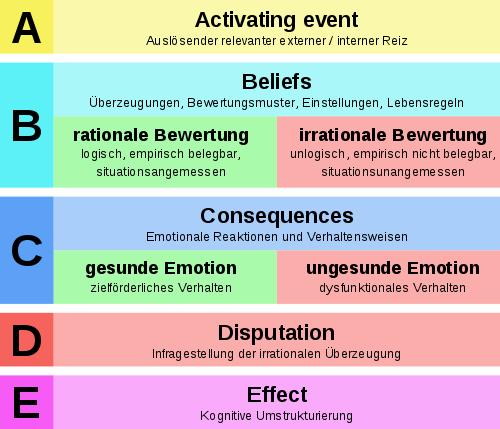ABC theory
The ABC theory according to Albert Ellis is based on the knowledge that certain perceived stimuli are (unconsciously) evaluated and these evaluations are the cause of the behavioral consequences derived from them.
ABC theory
The ABC theory model consists of the components A, B and C: A for activating event : stimulus → B for belief : evaluation of the stimulus A → leads to C for consequences : behavioral consequence .
Clinical case study
One patient recalls that before he collapsed on a train, he was not afraid to take the train.
Before the collapse, the following scheme arises:
A (stimulus: train) → B (evaluation: traveling by train is not dangerous) → C (consequence of behavior: no fear is felt)
However, since the train collapsed, the patient linked the situation and the train as a dangerous situation due to the collapse. The consequence is that after this event, the patient will evaluate trains negatively:
A (stimulus: train) → B (evaluation: traveling by train is dangerous because the train collapsed) → C (consequence of behavior: fear: the train is avoided)
The above example for an ABC is valid for general cognitive behavioral therapy (according to Beck etc.), but not for an ABC of REVT according to Ellis (cf. the Situational ABC model according to Dryden). Such a would be built on a REVT basis as follows:
A (Adversity): I could suffer another breakdown while traveling by train → B (irrational beliefs): Under no circumstances should I suffer another breakdown when traveling by train - I definitely couldn't bear that → C (Emotional: Fear; Behavioral: Avoid with driving the train; cognitive: possible distorted postirrational cognitions such as “I'm guaranteed to break down again”, “My heart can't take it and I will definitely get a heart attack” or similar).
Use in psychotherapy
Inappropriate assessments can often be observed in panic and anxiety disorders. This is also due to the fact that patients with an anxiety disorder often associate stimuli with fear (pathological finding). The aim of therapy is therefore to replace old, inappropriate cognitive-emotional assessments with new ones:
Example 1:
A (stimulus: meeting with a friend) → B (evaluation: I will blush and embarrass myself etc.) → C (behavior: fear of meeting)
Example 2:
A (stimulus: the train should be used) → B (evaluation: train travel is dangerous (experience, collapse on the train, reports of train accidents)) → C (behavior: train is avoided)
Example 3:
A (stimulus: the elevator should be used) → B (evaluation: it is narrow in elevators, I cannot escape) → C (behavior: elevator is avoided)
Example 4:
A (stimulus: I perceive every tiny change in my body) → B (evaluation: I am sick, I am in danger) → C (behavior: fear / panic reaction)
Therapeutic approaches:
The aim is to break through cognitive patterns and replace them with new ones. This can be done through Socratic questioning, through which the patient questions their thoughts and evaluations. Exposure therapy has also proven to be very effective: the patient should try to endure situations (e.g. elevator, train or meeting with a friend) in which he feels fear and learn not to behave in an avoidance. The patient should also recognize that his evaluations are inappropriate and that the situation / stimulus does not pose any danger. In addition, the patient should possibly change his perception (e.g. the perception of his own body).
See also
literature
- Beate Wilken: Methods of Cognitive Restructuring. A guide for psychotherapeutic practice , Verlag W. Kohlhammer: Stuttgart, Berlin, Cologne 1998.
- Holger Walther: Without fear of the wheel - master the driving test and drive independently, UVK: Munich and Konstanz 2017
Individual evidence
- ^ The ABC model according to Albert Ellis. Retrieved July 15, 2019 .
